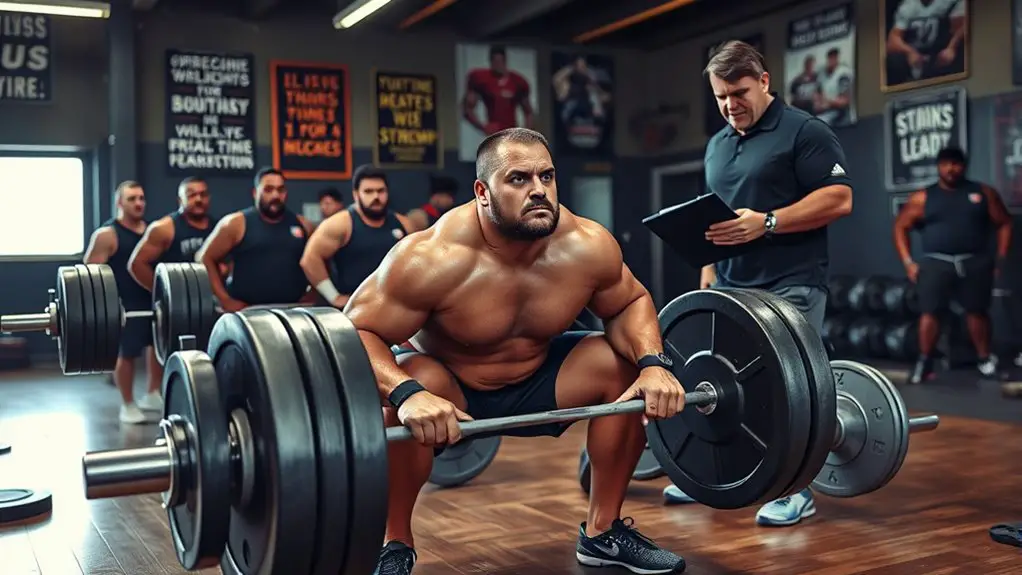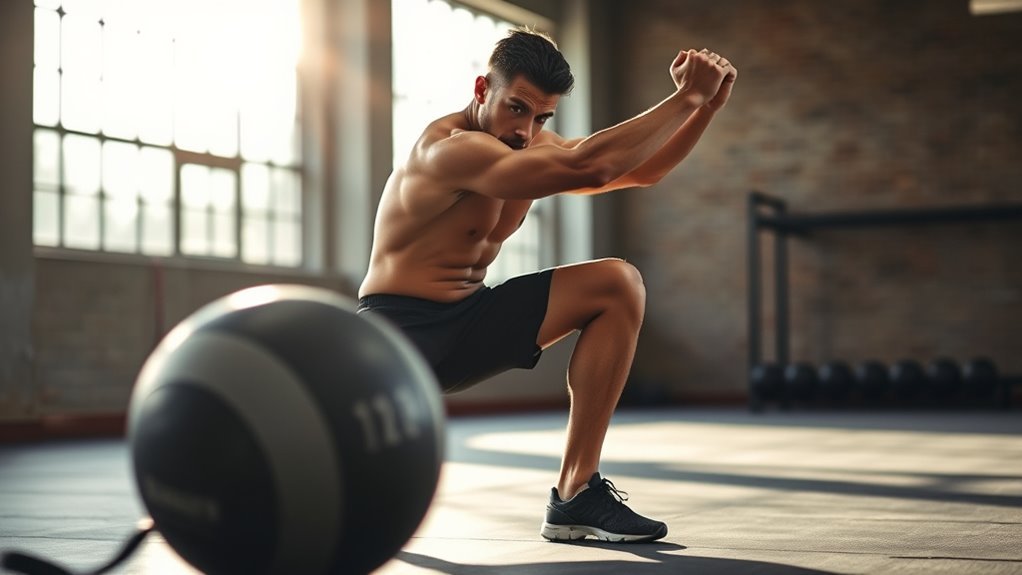High-Intensity Interval Training (HIIT) plays a vital role in boosting your athletic performance. By alternating intense exercise bursts with short recovery periods, you maximize effort and efficiency, leading to improved strength, speed, and endurance. HIIT enhances your cardiovascular system and aids in muscle adaptation, making workouts shorter yet more effective. Incorporating HIIT into your routine can truly elevate your game. If you're curious about how to implement it effectively, there's so much more to discover.
Understanding High-Intensity Interval Training (HIIT)
When you think about effective training methods, High-Intensity Interval Training (HIIT) often stands out due to its ability to boost athletic performance in a short amount of time. Understanding the HIIT basics can empower you to revolutionize your workouts. This method involves alternating between intense bursts of exercise and short recovery periods, allowing you to maximize effort while keeping your time commitment minimal.
You can choose various workout techniques, like sprinting, cycling, or bodyweight exercises, to tailor your HIIT sessions to your preferences. The beauty of HIIT lies in its flexibility; you can adapt the intensity and duration to fit your fitness level. Whether you're aiming for endurance, speed, or strength, HIIT provides the freedom to explore different approaches without being tied down to traditional, lengthy training routines. Interval training encourages personal expression while achieving fitness goals. Embrace this dynamic style, and watch your athletic performance soar!
Physiological Benefits of HIIT for Athletes
HIIT isn't just about saving time; it also offers numerous physiological benefits that can enhance athletic performance. One of the key advantages is muscle adaptation. By alternating between high-intensity bursts and recovery periods, your muscles are pushed to grow stronger and more resilient. This adaptation helps you perform better in your sport, giving you the edge you crave.
Additionally, HIIT boosts your metabolic efficiency. You'll not only burn calories during your workouts but also elevate your resting metabolic rate afterward. This means you're burning more calories even when you're not exercising.
As you embrace HIIT, you'll notice improvements in your overall conditioning, which translates into greater stamina and power during competitions. Incorporating muscular endurance training into your routine can further enhance your performance. So, if you're aiming for peak performance, incorporating HIIT into your training routine is a game changer. It's time to release your potential and enjoy the freedom that comes with being a stronger, faster athlete.
Enhancing Endurance and Speed Through HIIT
As you incorporate high-intensity interval training into your routine, you'll find that it markedly enhances both your endurance and speed. This method pushes your limits, allowing your body to adapt and grow stronger. By alternating bursts of maximum effort with brief recovery periods, you stimulate your cardiovascular system, leading to significant endurance improvement.
You'll notice that your body becomes more efficient at utilizing oxygen, which is vital for sustained performance. Coupled with this is speed development; those intense intervals foster faster muscle contractions, helping you sprint quicker and react sharper.
Ultimately, this dynamic approach not only elevates your physical capabilities but also invigorates your training sessions, offering a liberating break from monotonous routines. As you embrace HIIT, you'll discover newfound energy and resilience, enabling you to chase your athletic goals with greater freedom and enthusiasm. Additionally, improving oxygen delivery enhances your overall performance, setting the stage for even greater achievements. Your journey to enhanced endurance and speed starts here!
Incorporating HIIT Into Training Regimens
To effectively incorporate high-intensity interval training into your training regimen, start by evaluating your current fitness level and goals. This helps you create practical HIIT schedules that suit your needs. You might want to mix short bursts of intense activity with periods of rest or lower intensity. Aim for 20 to 30 minutes per session, two to three times a week, allowing your body to adapt and grow stronger. Additionally, integrating sprint drills can enhance your acceleration and overall athletic performance.
Don't forget about recovery strategies. Proper recovery is essential to prevent burnout and injury. Incorporate active recovery days with light activities like walking or yoga, which can enhance your overall performance. Keeping track of your progress can also help you stay motivated and make necessary adjustments to your HIIT schedules. Embrace the freedom that comes with this dynamic approach to training, and watch as your athletic performance thrives.
Success Stories: Athletes Who Thrived With HIIT
While many athletes have turned to high-intensity interval training to boost their performance, a few standout success stories truly highlight its effectiveness. HIIT champions have emerged in various sports, showcasing how this training method can transform athletic capabilities. Here are some inspiring athlete testimonials that demonstrate the power of HIIT:
- Olympic sprinter: Improved speed and endurance, smashing personal records.
- Professional soccer player: Gained explosive strength, helping the team clinch the championship.
- Triathlete: Enhanced overall fitness, leading to a podium finish at a major event.
- Marathon runner: Achieved faster times with less training duration, maximizing efficiency.
These athletes prove that incorporating HIIT into your regimen can lead to remarkable improvements. Additionally, the effectiveness of HIIT is supported by its ability to boost VO2 max, allowing athletes to perform at their peak for longer durations. If you're seeking freedom in your training and want to elevate your performance, search no further than the success stories of those who've thrived with this dynamic approach.
Frequently Asked Questions
Can Beginners Safely Start HIIT Training?
Can beginners safely start HIIT training? Absolutely! With the right approach, you can plunge into this exciting workout. Think of beginner modifications as your safety net; they'll support your journey while you build strength and endurance. Incorporating safety precautions like proper warm-ups and listening to your body guarantees you're not overexerting yourself. Embrace the freedom of movement, and remember, it's about progress, not perfection. You've got this!
How Often Should HIIT Sessions Be Performed Weekly?
When considering HIIT frequency, it's typically recommended to schedule 2 to 3 sessions a week. This allows your body enough time to recover while still reaping the benefits of high-intensity workouts. You can mix these sessions into your training schedule, ensuring you're balancing intensity with other forms of exercise. It's all about finding what feels right for you, so listen to your body and adjust as needed for that freedom to thrive!
What Equipment Is Needed for HIIT Workouts?
For HIIT workouts, you don't need much equipment to get started. A pair of dumbbells can add resistance to your exercises, helping you build strength while keeping your heart rate up. Resistance bands are also great for adding variety and challenge to your routine. With just these tools, you can create an effective workout that fits into your schedule and lifestyle, giving you the freedom to train wherever you please.
Are There Age Restrictions for HIIT Participation?
There aren't strict age restrictions for HIIT participation, but it's crucial to take into account youth suitability and senior participation. Younger individuals can benefit from HIIT, provided they're guided properly to avoid injury. For seniors, modifications are often necessary to accommodate fitness levels and health conditions. Ultimately, you should listen to your body and consult with a professional to guarantee you're engaging in a way that feels safe and fulfilling, regardless of your age.
Can HIIT Lead to Injuries if Done Incorrectly?
Yes, HIIT can lead to injuries if it's done incorrectly. To prevent injuries, it's essential to focus on proper form during exercises. If you rush through workouts without paying attention to how you're moving, you risk straining muscles or joints. Prioritizing injury prevention by ensuring you're using the right techniques allows you to enjoy your workouts while staying free and active. Always listen to your body and adjust your routine as needed.




